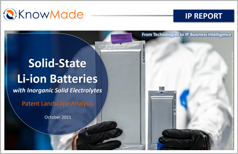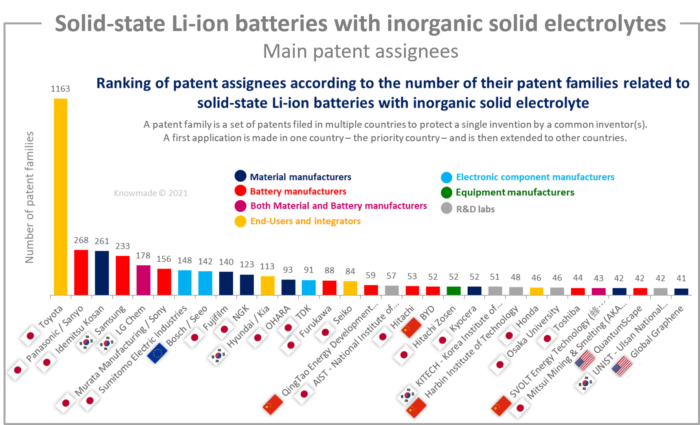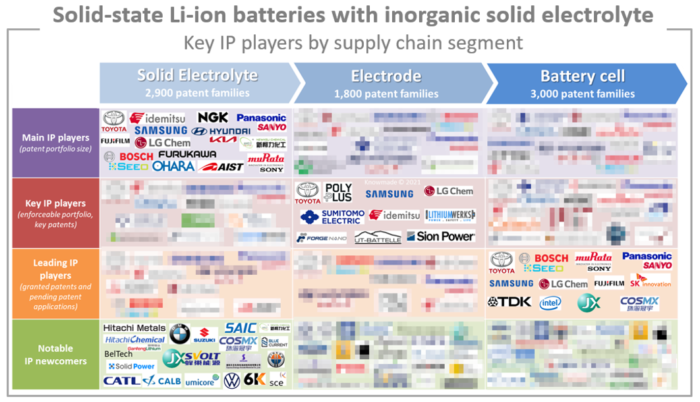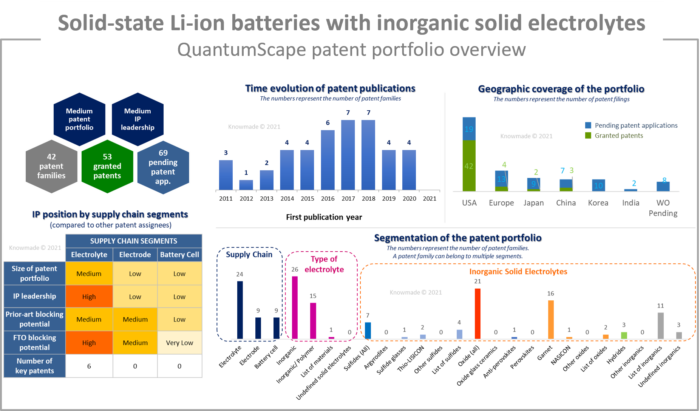
Japanese companies have dominated the patent landscape, but the last 3 years have seen an explosion in Chinese patenting activity, while automakers and numerous pure-play newcomers are entering the game.
Publication October 2021
| Download Flyer | Download Sample |
Report’s Key Features

- PDF with > 200 slides
- Excel file + Online database > 7,300 patent families
- IP trends, including time-evolution of published patents, countries of patent filings, legal status, etc.
- Ranking of main patent assignees.
- Newcomers in the IP landscape.
- Patent categorization by supply chain segments (electrolyte materials, electrodes, battery cells), type of electrolyte (inorganic, inorganic/polymer), and inorganic electrolyte materials (sulfide glass ceramics, Thio-LISICON, argyrodite, oxide glass ceramics, NASICON, perovskite, garnet, anti-perovskite, hydride)
- For each segment: IP dynamics, ranking of main patent assignees, IP newcomers, key IP players, key patents, and recent developments.
- Focus on patent portfolios of key players: Toyota, Samsung, LG Chem, Panasonic/Sanyo, Idemitsu Kosan, Fujifilm, Bosch/SEEO, Murata/Sony, Hyundai/Kia, Quantumscape, QingTao Energy Development, SVOLT, Ohara.
- For each key players: Time-evolution of patenting activity, legal status of patents and countries of patent filings, patent segmentation by electrolyte material, IP strength by segments, key patents and recent IP developments.
- Excel database containing all patents analyzed in the report, including technology, material segments, and hyperlinks to an updated online database.
Find more battery technology patent landscapes. KnowMade specializes in patent analysis to clarify this information and make it useful to entrepreneurs in scientific fields. Patent landscapes are part of these analyses.
Japanese players have a good IP position in the solid-state Li-ion battery field
Solid-state batteries with inorganic solid electrolytes hold a key position in the booming developments to get safer Li-ion batteries for electrical vehicles (EV) with greater autonomy and maximum speed. Solid-state batteries can be classified into two categories: thin-film solid-state batteries and “bulk” solid-state batteries. The thin-film technology approach proven for thin-film solid-state batteries is not directly applicable for bulk solid-state batteries. New processes and materials therefore have to be developed to get bulk solid-state batteries up to market requirements (performance, stability, cost). There are currently three main axes for development to enhance bulk solid-state battery performance: improve solid electrolyte performances; improve the electrode/electrolyte interface; and develop material/cell assembly manufacturing processes compatible with industrial production.
Many companies have recently presented solid-state battery prototypes and announced their commercialization and integration in electric vehicles by 2025. However, many questions remain: which solid electrolyte has the most promising performance? What are the most recent technological developments? Who has the best position across the supply chain?
In this context, Knowmade is releasing a new patent landscape report covering the whole value chain of solid-state Li-ion batteries with inorganic solid electrolytes from electrolyte materials to electrodes and battery cells. Patent landscape analysis is the perfect complement to market research, to fully comprehend the competitive landscape and technology roadmap, keep abreast of cutting-edge technology developments, anticipate future technology adoption, and understand the different competitors’ strategies. This kind of patent landscape report reveals the companies, technical solutions and strategies not identified through standard market analysis.
Knowmade’s analysts have selected and analyzed more than 14,400 patent filings grouped into 7,300+ patent families (inventions) related to solid-state Li-ion batteries with inorganic solid electrolytes. In this report, we reveal the main IP trends, key patented technologies, recent development trends, key IP players and newcomers, their strategies regarding inorganic solid electrolyte materials, and their IP strategies and strengths by supply chain segment and inorganic electrolyte material.
Understand the competitive landscape and IP strategy of key players
We have identified more than 1,000 different entities that have filed patent applications related to inorganic-based solid-state Li-ion batteries. The report provides a clear overview of the most active patent assignees as well as a presentation of newcomers to the patent landscape. Furthermore, patent segmentation reveals the IP position of patent assignees by supply chain segment (electrolyte materials, electrodes, battery cells) through a detailed analysis of their patent portfolios. We also provide insights into the key players’ patented technologies, their IP strategy, and their ability to limit other firms’ patenting activity and/or freedom-to-operate. The benchmarking of patent assignees is evaluated by supply chain segment, on the basis of their IP portfolio size, prior-art contribution, geographical coverage of the IP portfolio, and enforceability of their patents. A special focus is placed on the main IP collaborations (co-filings, license agreements, transfer of IP rights) related to solid-state Li-ion batteries with inorganic solid electrolytes.
Identify the leading IP players and IP newcomers across the supply chain, by electrolyte material
All patents selected for this study have been categorized by supply chain segment (electrolyte material, electrode, battery cells), electrolyte type (inorganic/polymer, inorganic) and inorganic electrolyte material (argyrodite, Thio-LISICON, sulfide glass ceramic, oxide glass ceramic, perovskite, anti-perovskite, LISICON, garnet, NASICON, hydride). For each supply chain segment, this report includes a time-evolution of patent applications, main and key patent assignees, newcomers, and a description of key and recently patented technologies. An understanding of the current technical challenges addressed in the patents is also presented.
Focus on key players’ patent portfolios
The report provides a detailed analysis of a selection of key players: Toyota, Samsung, LG Chem, Panasonic/Sanyo, Idemitsu Kosan, Fujifilm, Bosch/SEEO, Murata/Sony, Hyundai/Kia, QuantumScape, QingTao Energy Development, SVOLT, and OHARA. For each player, we summarize their IP portfolio, highlight their strengths and weaknesses by segment, identify their key patents and provide information about their recent IP developments.
Useful Excel patent database
This report also includes an Excel database with the 7,300+ patent families (inventions) analyzed in this study. This useful patent database allows for multi-criteria searches and includes patent publication numbers, hyperlinks to an updated online database (original documents, legal status, etc.), priority date, title, abstract, patent assignees, patent’s current legal status, and segments (electrolyte materials, electrodes, battery cells, inorganic, inorganic/polymer, sulfide glass ceramics, Thio-LISICON, argyrodite, oxide glass ceramics, NASICON, perovskite, garnet, anti-perovskite, hydride, etc.).
Companies mentioned in this report (non-exhaustive list)
AGC, Albemarle, Alps Electric, Amperex Technology/TDK, Asahi Kasei, BASF, Belenos Clean Power, Blue Solutions/Bolloré, Bosch/Seeo, BYD, Daiso, DKS, Dow/Corning, FDK, Fujifilm, Fujitsu, Furukawa, GS Yuasa, GLESI (Guilin Electrical Equipment Scientific Research Institute), Hitachi Chemical, Hitachi Maxell, Honda, Honeycomb Energy, Huawei, Hydro Quebec, Hyundai/Kia, Idemitsu Kosan, Ionic Materials, Johnson Matthey, JSR, LG Chem, Lionano, Lishen, Lithium Werks/Valence Technology, Mitsubishi Chemical, Mitsubishi Materials, Mitsui Chemicals, Murata/Sony, Nakajima Industry, NGK, Nippon Chemical Industrial, Nippon Electric Glass, Nippon Shokubai, Nippon Soda, Nissan, NOF, Nohms Technologies, Ohara, Optimumnano Energy, Panasonic/Sanyo, Polyplus Battery, Qingtao Energy, Quantumscape, Saft/Total, Samsung Electronics, Samsung SDI, Schott, Seiko, Shin Etsu Chemical, Sila Nanotechnologies, Solid Power, Solvay, Sumita Optical Glass, Sumitomo Chemical, Sumitomo Metal Mining, Toho Titanium, Toray Industries, Toshiba, Toyota, Wildcat Discovery Technologies, Yuhuang Chemical, Zeon, CEA, CNRS, FZ. Juelich, KAIST, MIT, NIAIST, NIMS, Osaka University, Tokyo Institute of Technology, University of Chicago, University of Colorado, University of Michigan, University Tohoku, etc.
